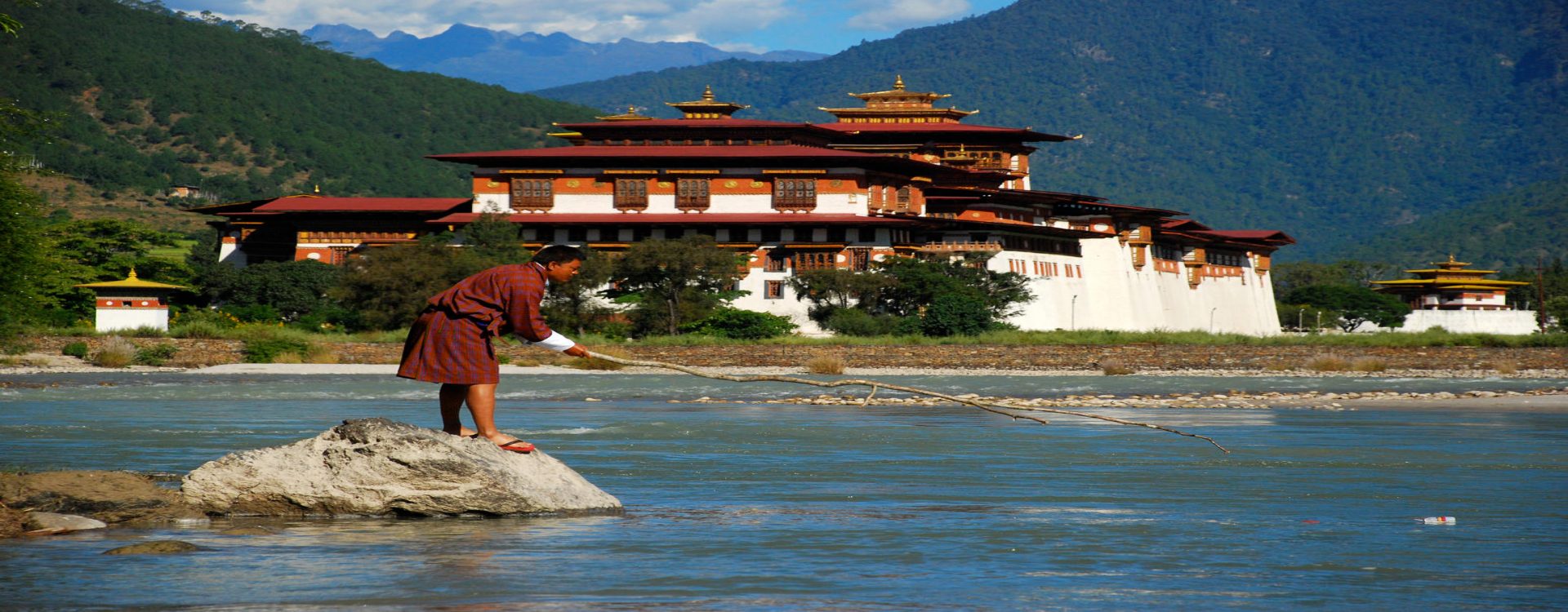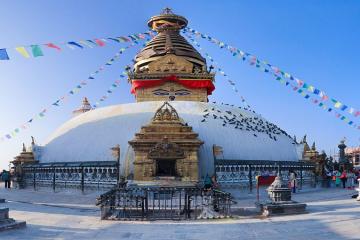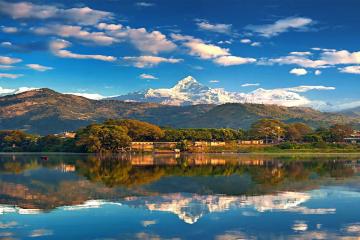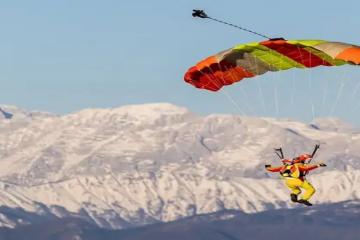

Those wishing to experience the ultimate Himalayan experience in both Nepal and Bhutan and see the cultural and natural differences that exist in these two neighboring countries must go on this Scenic Nepal Bhutan Tour.
The tour begins in Nepal in the mystical city of Kathmandu. Nepal, by demographics, is more Hindu than Buddhist, nearly the opposite of Bhutan which is predominantly Buddhist. Nepal has closer ties to India culturally while Bhutan is culturally most similar to Tibet. This is seen in their temple architecture, monastery architecture and in general the food and the way of life and language. In Kathmandu you will begin by touring the UNESCO world heritage sites of Kathmandu and Bhaktapur durbar square. You will also get to visit Pharphing and Dakshinkali temples located slightly away from Kathmandu valley. This should give you a brief but concise picture of the livelihood and cultural sentiments and practices of the country of Nepal.
After your time in Nepal, we will take a short 1-hour flight from Kathmandu to Paro, the location of the international airport in Bhutan. From Paro, we will take a short one-hour drive to the capital Thimpu. In Bhutan, we explore numerous Dzongs, Tibetan-style monasteries, and take note of the numerous differences and similarities. The Takshang monastery, Late King Memorial Chorten, Punakha Dzong, Gangtey Monastery all lie in wait for you to explore them and get to know more about Bhutan. While Both countries are very similar in geography, Bhutan is noticeable more covered by green hills and forests. This is due to the difference in administrative influence on environmentalism and sustainability which is heavily emphasized by the Bhutanese royal family.
Thus, the Scenic Nepal Bhutan tour is a once-in-a-lifetime package, that to put it bluntly, kills two birds with one stone, giving you the best experience the Himalayas has to offer.
Countries like Bhutan and Nepal are particularly susceptible to the effects of the monsoon. The monsoon season in both nations often lasts for close to two months, from about July to August. This time around, the rain will make the excursion messier and less pleasurable overall because it will restrict both the views and the opportunities for exploring. Winter, from December to Feburary, can be a pleasant season to visit either location, despite the chillier temperatures and increased likelihood of significant snowfall in the higher mountain regions. In general, the months of spring (April to May) and autumn (October to November) are the greatest times to travel to Nepal and Bhutan together, since these are the months during which the weather is most favorable for a holiday that is truly delightful.
However, as autumn is the busiest time of year in Nepal and Bhutan, it is in your best interest to make reservations as far in advance as possible. Both countries have a decrease in activity during the spring, which coincides with the enticement of new growth, which adds brightness and delight to the landscapes all around the Himalayas.
Accessible Adventure is a travel and tour organization run and managed by a team of experienced, veteran Nepalese nationals. This personnel has vast experience organizing and managing vacation locations in Bhutan, Nepal, and Tibet across the Himalayas.
We are a leading and ascending travel company situated in Kathmandu, Nepal, with over a decade of expertise executing successful tours with one-of-a-kind quality services at reasonable pricing. During your stay with us, you will be able to enjoy all of the Himalayan vacation locations that we provide.
Every one of our vacations is meticulously planned and coordinated, and we receive constantly positive feedback from both past and present customers and clients. They express great satisfaction and appreciation for the value of the vacations we provide.
When you get to Kathmandu, we will be there to meet you at the airport to greet you. While you are in our care, we will make sure that all of your travel needs are met in a timely manner. Since there are no plans for activities for the day, we will assist you in checking into the appropriate accommodation since there are none scheduled. You have the option of either going for a walk around the neighborhood or unwinding in each of your own rooms.
After Breakfast, we move via private vehicle to take a short hike to Namo-Buddha. We stop at Panauti Bus Stop and begin our hike towards Namo Buddha. Namo Buddha is a famous monastery with amazing views of the surrounding hills and the Kathmandu Valley. The first 2.6 kilometers (km) of the hike are on asphalt roads. Even though this part of the trek is the least interesting, you'll get to see villagers working in the fields and kids playing in the courtyards. When you get to Sunthan Bus Stop, turn right at the trail's fork and walk south toward Khopasi Bus Stop. Walk along the relatively flat and easy Khopasi Khasthali Road on a single-track path that takes you through small, charming villages. From these villages, you can see beautiful views of the valley before you.
The hardest part of the hike is the second part. As you walk 9.2 km, you'll gain almost 750 m in height. Even though the trail is easy from here on out, you might want to stop often to get your energy back for the walk ahead. The trail then goes down a gentle slope to the small village of Lapsibot. From here, the trail heads northeast and goes uphill as it goes uphill. Along the way, you'll probably run into other hikers and locals. As you go up, the view of the monastery and stupa in the distance and the majestic mountains in the background gets better and better.
When you see hundreds of thousands of prayer flags flying above the golden roofs of the Namo Buddha monastery, you'll know right away where it is. From this vantage point, you can see the beautiful valley you just hiked through and enjoy the quiet. Make sure to drink water at a nearby restaurant for lunch. Your hike ends here. You can explore the wonderful Namo buddha monastery and meditate and soak in the spiritual vibe. After that you will be picked up in the Parking area of the monastery and brought to Bhaktapur Durbar Square.
Bhaktapur is an old city lying just half an hour drive from Kathmandu. It contains the UNESCO world heritage site of the Bhaktapur Durbar square which contains numerous temples and museums worth exploring. In Bhaktapur, Nepal, Bhaktapur Durbar Square is a complex that used to be a royal palace. From the 14th to the 15th centuries, it was home to the Malla kings of Nepal. From the 15th to the late 18th centuries, it was home to the kings of the Country of Bhaktapur. The kingdom was taken over in 1769. The square is one of the most beautiful examples of architecture in the Valley. It shows off Nepal's medieval arts. The Palace with its 55 windows is the most important building in all of Durbar Square. In the 15th century, this amazing building was built. King Bhupatindra Malla is sitting on the top of a very tall column.
The Nyatapola temple is the most well-known pagoda in Nepal. Nyatapola means "five tires" in the Newari language, which stands for the five most important things. This is the tallest pagoda in Nepal. It was built with great skill and artistic beauty.
The Buddhist community of Pharphing is likewise very significant. Guru Padmasambhava became a Mahamudra vidyadhara in the holy site of Yangleshö, located in the Nepalese town of Pharping to the south of Kathmandu. Katok Rigdzin Tsewang Norbu considers Yangleshö to be equally important to Vajrayana practitioners as Bodhgaya since it is the site where Padmasambhava attained enlightenment. Guru Rinpoche has bestowed his blessing on two main practice caves in Pharping: the Asura cave and the Yangleshö cave.
Known variously as Dakshinkali Temple, Dakshin Kali Temple, and Dakshina Kali Temple, this Hindu temple to the goddess Kali is located 22 kilometers (14 miles) from Kathmandu, on the outskirts of the village of Pharping. Usually, Dakshin Kali is depicted with her right foot on Shiva's chest, but when her left foot is on Shiva's chest, she is shown as the even more terrifying Vamakali. The goddess is primarily worshiped through the sacrifice of animals, mainly cockerels and uncastrated male goats, which may be observed most vividly during the Dashain festival.
After the tour, we head to the Kathmandu durbar square in the evening. The site on the UNESCO list Kathmandu Durbar Square is one of Nepal's Kathmandu Valley's three squares. Even though most of the square was built in the 1600s, it is thought that work on the square and palaces began as early as the 3rd century. The Hanuman Dhoka Palace Complex in Kathmandu's Durbar Square was the royal palace of Nepal until the 19th century. It was the place where the Nepalese monarch was crowned and other important events took place. The Palace was turned into a museum not too long ago. One of Nepal's most interesting buildings is the Kumari Chok, which is at the southern end of Durbar Square. This safe bubble is home to the Raj Kumari, a girl who was chosen through an old and mysterious process to become the Hindu mother goddess Durga in human form.
Today, we fly from Kathmandu Airport to Paro early in the morning. We'll pick you up in a private car two hours before your flight, giving you plenty of time to go through airport procedures. From Kathmandu to Paro, it takes about an hour and a half to fly. We'll pick you up at the Paro airport and drive you in a private car to Thimpu, the capital city of Bhutan.
Today, we will go to the Thimpu Tashichho Dzong and the National Memorial Chorten. In 1974, the National Memorial Chorten was built as a memorial to the third king of Bhutan, Jigme Dorji Wangchuk (1928-1972). The Thimphu Tashichho Dzong is a fortress and Buddhist monastery in Thimphu. It has a unique Bhutanese style of architecture. This building is on the banks of the Wang Chhu river. It is the current home of the Druk Desi, the head of the civil administration, and the office of the current monarch.
After the tour, we'll take you back to your hotel for the night, or you can take a walk around Thimpu.
We will take a scenic drive to the Buddha point in Kuenselphodrang National park after you wake up and we eat breakfast. It has one of the biggest Buddha statues that is sitting in the world. It is perched on a hill, from which you can see a wide view of the valley and the nearby mountains.
From here, we go to the Sangaygang tower, which has a great view from the top of the hill. You might also see the animal that is the symbol of Bhutan.
The Dechen Phodrang is another place we go. It has been the location of the state monastic school since 1971, and a long line of monks often walks between this building and the dzong. Over the course of eight years, a group of fifteen teachers teach more than 450 students. In Bhutan, we also go to a living museum and a photo studio that show the traditions and cultural diversity of the country. The last place we go is the Simtokha Dzong, which is five miles from Thimpu and was one of the first Dzongs built in 1627.
We leave Thimpu for Punakha today after breakfast. We will stop at Dochula Pass today on the way to Punakha, which was the capital of Bhutan until 1955. Today, we're going to Punakha. This popular place for tourists has breathtaking views of the Himalayas in every direction. It is also where the 108 Druk Wangyal Chortens are. These were built on a small hill as a memorial to the Bhutanese soldiers who died in a battle in 2003.
We also go to the Pho Chhu Suspension Bridge, which is the longest suspension bridge in Bhutan. It is 160 meters long. From this bridge, you can see Punakha Dzong and the Pho Chhu Valley in a beautiful way.
We will check out the Khamsum Yuley temple in Punakha. There is no other temple in Bhutan that is as ornately made as this one. The Queen Mother of the Fifth King built this beautiful temple with the hope that it would bring peace to the whole world. Some of the most impressive works of spiritual art are on the walls inside the building. Also on the walls are paintings of Buddhist masters and guardian deities who keep the kingdom safe. This is a great temple to visit if you want to try to figure out what the paintings and sculptures mean.
We will also have a traditional dinner at a traditional home in Punakha. This will give you a chance to learn about how people in Bhutan live.
On the long drive from Wangdue to Mangde Chhu Valley, you pass through a rural area with no trees and cross the Black Mountain via the Pele la (3240 m) mountain pass. Trongsa is in the middle of Bhutan. It is on a steep slope above a river gorge and has a beautiful view. We'll go to the Trongsa Dzong, which is the tallest building in the Trongsa area.
Leave Trongsa for Wangdue Region. We will enter Gangtey Valley and go down to the western ridges of the Black Mountains. Gangtey Valley is protected as a haven for a wide range of animals and plants, such as black-necked cranes, muntjacs, wild boars, and Himalayan black bears. You will see more ways of living that have been around for a long time.
You can take a walk through the beautiful Phobjikha Valley and stop by Gangtey Monastery, which is Bhutan's only and largest Nyingmapa monastery. The last thing we'll do is drive back to Wangdiphodrang.
We will be entering Gangtey Valley and descending to the western ridges of the Black Mountains once we have left Trongsa for the Wangdue Region. Gangtey Valley is a protected area because of the wide range of animals that live there, such as black-necked cranes, muntjacs, wild boars, and Himalayan black bears. This makes the valley a paradise for a wide variety of plants and animals. You will observe lifestyles that are more traditional and date back many years before your time.
You may go for a stroll in the entrancing Phobjikha Valley and check out Gangtey Monastery, which is Bhutan's sole Nyingmapa monastery and the country's largest. In the end, we shall make our way back to Wangdiphodrang by car.
After breakfast, we take a short drive to the foot of Tiger's Nest, where we begin our two-hour ascent to the monastery cafe, where we are rewarded with a breathtaking panorama of Taktsang. After another half-hour of hiking, we'll reach the majestic Taktsang and be greeted by the resident monks. It is thought that from Singye Dzong in Eastern Bhutan, Guru Rimpoche flew on a flaming tigress to here, Bhutan's holiest monastery, where he meditated for three months. Beginning in the eighth century, under his leadership, Buddhism in Paro flourished. He flew here from Tibet on the back of Yeshe Tsogyal, who he turned into a flying tigress for the trip. He landed on the cliff, which he "anointed" as the place to build a monastery. People have called him the "protector saint of Bhutan" because he brought Buddhism and the Nyingmapa school of Mahayana Buddhism to Bhutan. In the monastery, there are eight caves. Four of them are pretty easy to get to. Padmasambhava is thought to have entered the first cave on the back of a tiger. This cave is called "Tholu Phuk," and the cave where he meditates is called "Pel Phuk."
All of the monastic structures are cut directly into the cliff face, which has extraordinarily steep slopes. Despite its intimidating appearance, the monastery complex may be reached from multiple directions. These include the northwest by a path through the forest, the south via a path used by devotees, and the north via the "Hundred Thousand Fairies".
We descend back and stay overnight in Paro.
Today, we will say goodbye to this beautiful country in the Himalayas. We hope that by now you have made some friends and taken lots of photos to remember Bhutan. We hope to see you again in this beautiful land of never-ending Enchantments. Tashi Delek!
Want to make your own customized trip ? Click Here


